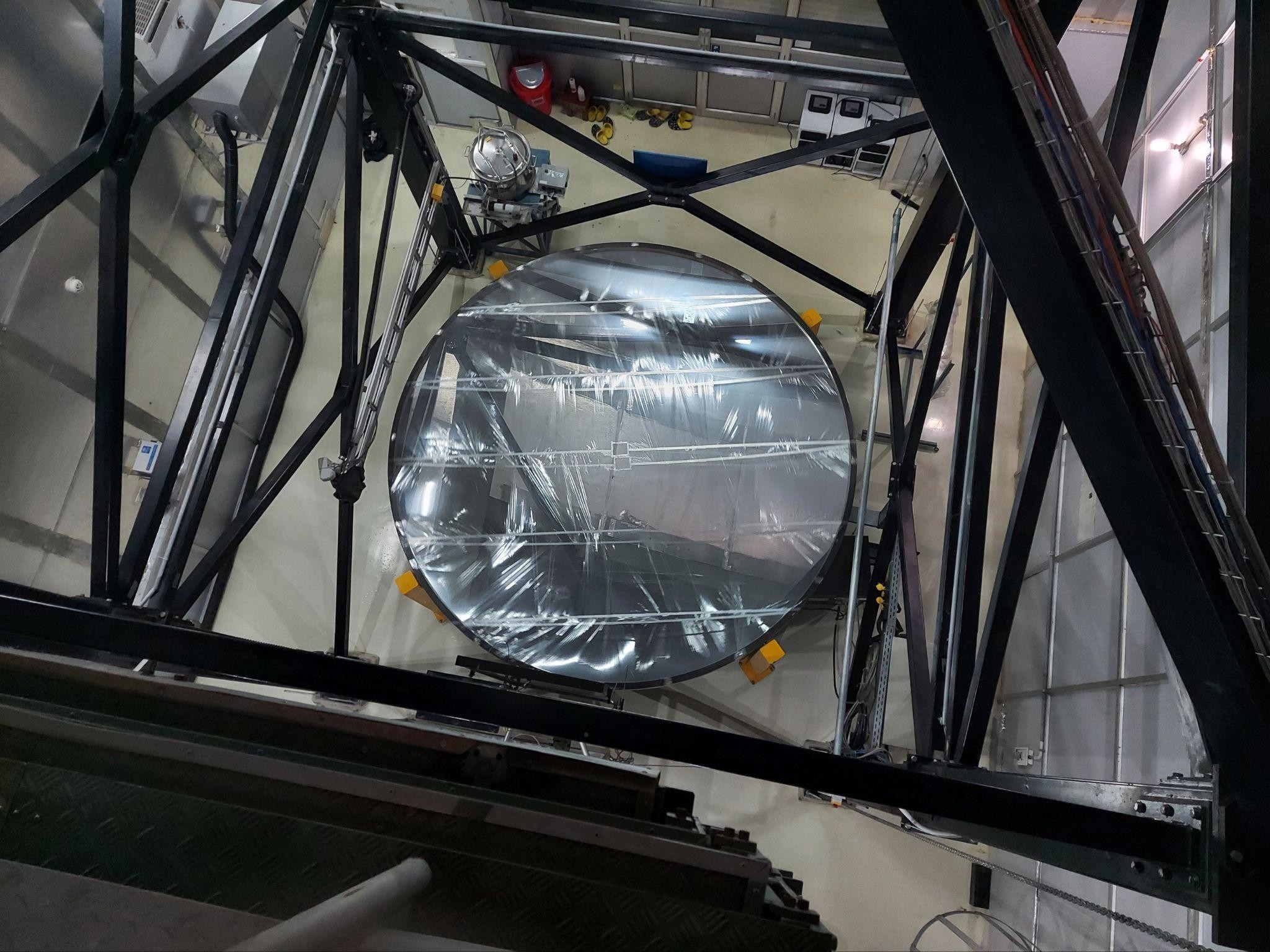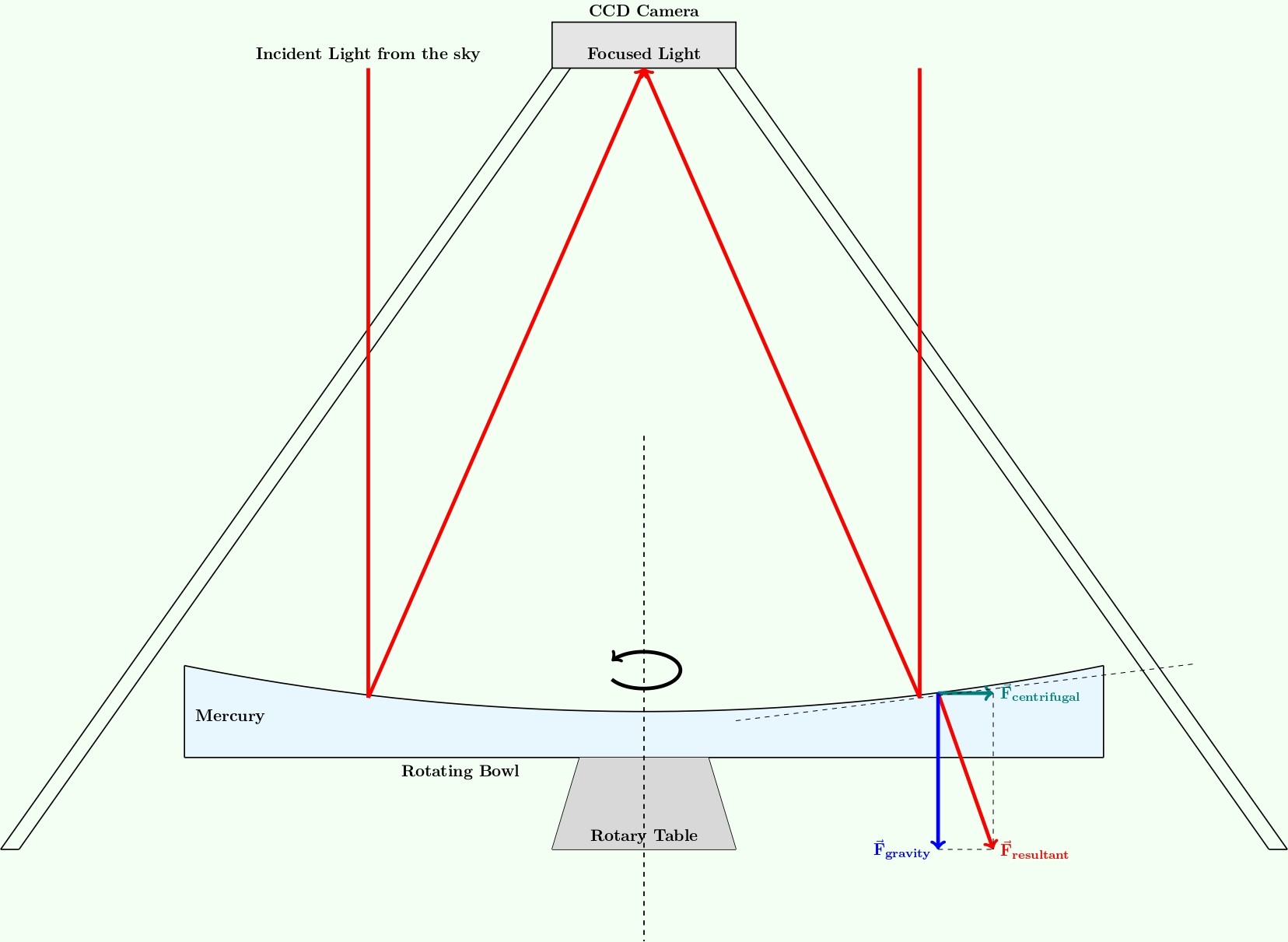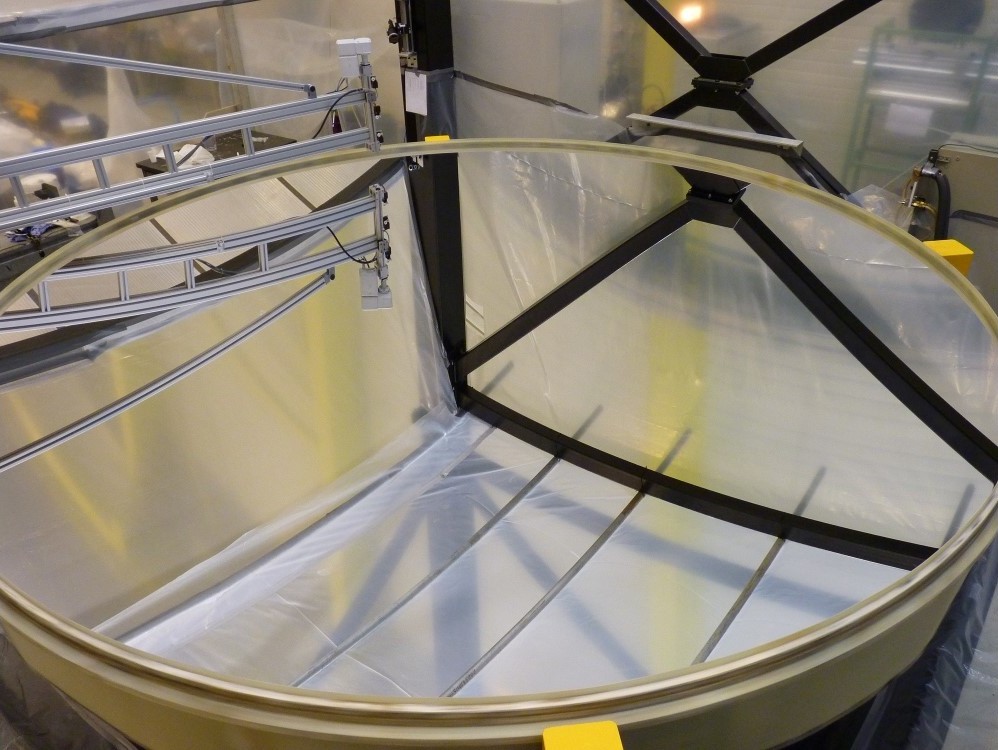The International Liquid Mirror Telescope in the Himalayas and its AI-driven Quest to Discover Rare Cosmic Explosions
In March 2023, the International Liquid Mirror Telescope (ILMT) was inaugurated at Devasthal in the district of Nainital, Uttarakhand. The project results from an international collaboration between India (ARIES, Nainital), Belgium (Liège University), and Canada (six Canadian universities). Situated in the picturesque setting of the Himalayas at an altitude of 2450m, the telescope is unique in many ways. Unlike the conventional optical telescope, which uses glass-based mirrors to reflect light from the night sky to make pretty images, the ILMT uses mercury, a liquid at room temperature that can reflect light. The choice of mercury reduced the cost of construction by more than tenfold. The ILMT is the only operational liquid mirror telescope in the world.

Fig 1: Top view of the primary mirror of the International Liquid Mirror Telescope (ILMT) in Devasthal, Nainital.
A generic structure of any telescope has single or multiple curved mirror(s) to reflect light and a camera to record images from the reflected light. This requirement poses a challenge when using liquid mirrors, as their surface cannot be ‘curved’ when held stationary. The solution to this problem is to pour the mercury into a large bowl and rotate the bowl at a uniform speed. You might have noticed that when you rotate a bowl filled with water, the surface no longer remains flat and becomes rather curved (technically, the shape is called a paraboloid). The idea is not new; in fact, the idea was floated as early as 1850 by the Italian astronomer Ernesto Capocci. After that, a few attempts were made to construct a liquid mirror telescope, but they all fell short for one specific reason. The rotation of the mercury bowl couldn’t be made perfectly smooth and was hampered by small vibrations. This induced ‘jitter’ in the images, rendering them not very useful for doing astronomy. This is analogous to a situation where you try to take a picture with a shaky camera, resulting in blurred photos.
It was not until 1982 when an Italian-Canadian astronomer, Ermanno F. Borra, realised that technological advancements made over the preceding few decades could address a few practical challenges faced by such telescopes. Subsequent developments by Ermanno Borra, Paul Hickson and their collaborators culminated in the construction of the ILMT. The bowl of the ILMT has a diameter of 4 meters and can hold up to 50 litres of mercury, weighing around 700 kilograms. This bowl sits atop a rotary table that makes eight full revolutions every minute. The rotation speed is precise enough to focus the light on the digital camera, which is mounted vertically above the rotating bowl. One significant advancement was the technology behind the rotary bowl, which used modern air bearings to eliminate vibrations. This made the mirror movement smooth and, hence, the images sharper. The construction of this kind of telescope constrains the entire structure, including the rotating mirror and the camera, to be one stationary unit.

Fig 2: Image formation in a Liquid Mirror Telescope. Light from the zenith sky is focused on the CCD camera, where the image is formed. The surface of the mercury is perpendicular to the total force at every point, which is the result of the centrifugal force due to the rotation of the bowl and the gravity. The resulting force gives the surface its paraboloid shape.

Fig 3: The ILMT mirror made out of mercury in a spinning bowl during testing at Liège in Belgium.
As a result, the telescope can point only towards the zenith direction, as any other direction will be unfeasible and make the mercury spill over. Hence, unlike traditional telescopes, it cannot move to track the objects in the moving sky to acquire “stationary” images and end up capturing light trails of the stars. This problem was addressed by another technological advancement in the form of digital camera chips (also known as charged coupled devices or CCDs). The light-generated charge in these chips can be drifted continuously to keep pace with the moving sky (known as time-delay integration), resulting in stationary images. Over the past three years, the telescope has been capturing the zenith sky over Devasthal, resulting in thousands of images of great scientific value.

Fig 4: Discovery of a supernova candidate AT2024fxn using the ILMT on the 5th of April 2024. The discovery was assisted by a custom-built artificial intelligence (AI) based algorithm for the ILMT. The figure shows the appearance of a new supernova candidate in the middle of a new image (left), which was absent from the older image (centre). The distant galaxy in which this event occurred can be seen in the top right-hand corner of the first two images. The image on the right is the subtracted image containing only the candidate.
An important scientific objective of the ILMT is to detect and discover a class of astronomical phenomena known as transients. Transient is an umbrella term that refers to changes in the sky that happen over a small timescale. Examples of transients are moving asteroids, stars changing brightness over a few days, and flashes of light due to stars exploding in distant galaxies, also known as supernovae. A nice method to search for such transients is by effectively subtracting images of the same part of the sky captured on two different nights with a telescope like the ILMT. The result of this subtraction should only contain objects that have changed, a.k.a. transients. This technique, known as image subtraction, can locate transients in the images and, correspondingly, in the sky. The ILMT captures large volumes of image data, and manually analysing all the subtracted images every night to find transients is impractical.
Fortunately, advancements in AI can come very handy in this situation. It was realised that convolutional neural networks (CNN), are uniquely suited to deal precisely with this scenario. The CNNs work by taking images as input and identifying their type. In the problem, CNN successfully identified transients in the subtracted images and subclassified them into probable types. Leveraging the power of AI, researchers were able to find thousands of transients in the ILMT images, including 16 rare supernova-like extragalactic transients. Four out of the 16 were discoveries and were reported likewise. Other telescopes also carried out detailed follow-up observations of these transients. Such a study could provide insights into the nature of these events and unlock the mechanisms driving them.
The ILMT exemplifies how incremental advancements over generations can transform an ambitious idea into a scientific success. Its cost-effective and innovative design may serve as a blueprint for future telescopes, inspiring researchers to push beyond existing ideas and drive transformative scientific and technological breakthroughs.
Publications:
- The 4m International Liquid Mirror Telescope: Construction, operation, and science
J. Surdej, P. Hickson, K. Misra, D. Banerjee, B. Ailawadhi, T. Akhunov , E. Borra, M. Dubey, N. Dukiya, S. Filali, J. Hellemeier, M. Kharayat, B. Kuma , H. Kumar, M. Kumar, T. S. Kumar, P. Kumari, V. Negi, A. Pospieszalska-Surdej, S. Prabhavu, B. Pradhan, K. Pranshu, H. Rawat, B. K. Reddy, A. Sasidharan Pillai, K. Singh, S. Tremblay, S. Turakhia, and S. Vijay
Astronomy and Astrophysics (A&A), 2025, 694, A80
https://doi.org/10.1051/0004-6361/202452667
https://ui.adsabs.harvard.edu/abs/2025A%26A...694A..80S/abstract
- PyLMT: A transient detection pipeline for the 4-m International Liquid Mirror Telescope
Kumar Pranshu, Kuntal Misra, Bhavya Ailawadhi, Monalisa Dubey, Naveen Dukiya, Sara Filali, Paul Hickson, Brajesh Kumar, Vibhore Negi and Jean Surdej,
Monthly Notices of the Royal Astronomy Society (MNRAS), 2025
https://ui.adsabs.harvard.edu/abs/2025arXiv250200556P/abstract
Contact persons:
Prof. Jean Surdej (Liège University, Belgium) jsurdej[at]uliege[dot]be
Prof. Paul Hickson (University of British Columbia, Canada) hickson[at]physics[dot]ubc[dot]ca
Dr. Kuntal Misra (ARIES, Nainital, India) kuntal[at]aries[dot]res[dot]in
Mr. Kumar Pranshu (PhD student, ARIES, Nainital, India) pranshu[at]aries[dot]res[dot]in

